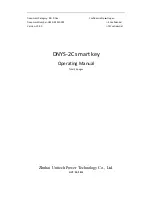
English
WIB-31 | WIB-32 | WIB-33
F0 by assigning them to a second address. The functions F10 to F15
are not available in Motorola format.
The assignment of the function keys to
the LEDs,
the function outputs of the decoder,
further functions (switching on and off the orientation light and the
dimmer switch)
can be done freely. It is possible to assign several function keys to one
LED, one function output or one function.
Operation in analogue mode
The carriage lighting WIB-31 to –33 can also be used in analogue
model railway layouts. When putting the vehicle on the rails the
decoder recognizes automatically if it is run in analogue or digital mode
and sets the corresponding operation mode. The automatic recognition
of the analogue mode can be switched off.
Switching the LEDs and the function outputs on or off is not possible in
analogue mode. They can be programmed so that they are either
switched on or off in analogue mode. The effects set for the outputs
are active in analogue mode as well.
In analogue layouts supplied with d.c. voltage, the function outputs
switched with F0 are switched on and off according to the direction of
travel. This is not possible in analogue a.c. layouts as the decoder does
not recognize the impulse for changing the direction of travel.
Activating the LEDs
The eight LEDs can be switched on and off individually, in groups or
corporately. By programming the decoder accordingly you can
set the LEDs´ brightness individually for each LED,
switch the LEDs according to the direction of travel,
simulate fluorescent tubes when switching on the LEDs,
set the duration of the switching on of the fluorescent tube
simulation until reaching a constant light and a defective fluorescent
tube individually for each LED.
You can switch from standard lighting to orientation light with a
function key (e.g. for holded carriages or sleeping cars). The orientation
light´s brightness is set corporately for all LEDs.
Instead of programming the LEDs´ brightness with a digital control unit
you can set it with a trim-pot (corporately for all LEDs). The brightness
programmed via CVs or register remains active, the settings at the trim-
pot only alter the brightness with a factor valid for all LEDs.
Activating the addtional function outputs
There are three outputs for external loads on the PCB controlled by the
integrated decoder. The output AUX2 is designed for the connection of
LEDs for the back lighting. The necessary series resistors are integrated
on the PCB.
The two outputs AUX1 and AUX3 are available e.g. for the connection
of additional lighting (e.g. in the driver´s cabin or in the toilet cabin) or
electric couplings. Their maximum current is 300 mA.
It is possiblie to switch all outputs dependent on the direction of travel
and to dim them.
Besides, the two outputs AUX 1 and AUX 3 provide:
Kick function for special types of electric couplings needing a
reduction of the connected voltage after the switching operation in
order to protect the coupling.
Page 28
tams elektronik









































